Examining the Impacts of Pre-Fire Forest Conditions on Burn Severity Using Multiple Remote Sensing Platforms
Abstract
1. Introduction
2. Study Area and Methods
2.1. Study Area and Fire Regime
2.2. Vegetation Structural and Topographical Variables Derived from Aerial LiDAR
2.3. Spectral Indices to Derive Burn Severity and Vegetation Functional Variables Using Satellite Imagery
2.4. Pre-Fire Land Cover Classification
2.5. Correlation Analysis and Stepwise Regression Using Mallow’s C(p)
- is the sum of squared errors (residual sum of squares) for the model with p predictor variables;
- is the estimated error variance for the full model (model with all predictor variables);
- n is the number of observations in the data;
- p is the number of predictor variables in the model.
2.6. Analyzing Residual Values with Geary’s C
3. Results
3.1. Correlation between Environmental Variables and Burn Severity Indices
3.2. Stepwise Regression Analysis Using Land Cover Classification Results
3.3. Calculating Spatial Distribution Using Geary’s C
4. Discussion
5. Conclusions
Author Contributions
Funding
Data Availability Statement
Acknowledgments
Conflicts of Interest
References
- Keeley, J.E.; van Mantgem, P.; Falk, D.A. Fire, climate and changing forests. Nat. Plants 2019, 5, 774–775. [Google Scholar] [CrossRef] [PubMed]
- DeBano, L.F.; Neary, D.G.; Ffolliott, P.F. Fire Effects on Ecosystems; John Wiley & Sons: Hoboken, NJ, USA, 1998. [Google Scholar]
- Davis, K.T.; Dobrowski, S.Z.; Higuera, P.E.; Holden, Z.A.; Veblen, T.T.; Rother, M.T.; Parks, S.A.; Sala, A.; Maneta, M.P. Wildfires and climate change push low-elevation forests across a critical climate threshold for tree regeneration. Proc. Natl. Acad. Sci. USA 2019, 116, 6193–6198. [Google Scholar] [CrossRef] [PubMed]
- Dove, N.C.; Safford, H.D.; Bohlman, G.N.; Estes, B.L.; Hart, S.C. High-severity wildfire leads to multi-decadal impacts on soil biogeochemistry in mixed-conifer forests. Ecol. Appl. 2020, 30, e02072. [Google Scholar] [CrossRef] [PubMed]
- Rengers, F.K.; Tucker, G.E. The evolution of gully headcut morphology: A case study using terrestrial laser scanning and hydrological monitoring. Earth Surf. Process. Landf. 2015, 40, 1304–1317. [Google Scholar] [CrossRef]
- Broxton, P.D.; van Leeuwen, W.J.D.; Biederman, J.A. Forest cover and topography regulate the thin, ephemeral snowpacks of the semiarid Southwest United States. Ecohydrology 2020, 13, e2202. [Google Scholar] [CrossRef]
- Collins, B.M.; Fry, D.L.; Lydersen, J.M.; Everett, R.; Stephens, S.L. Impacts of different land management histories on forest change. Ecol. Appl. 2017, 27, 2475–2486. [Google Scholar] [CrossRef] [PubMed]
- Keeley, J.E. Fire intensity, fire severity and burn severity: A brief review and suggested usage. Int. J. Wildland Fire 2009, 18, 116–126. [Google Scholar] [CrossRef]
- Conard, S.G.; Sukhinin, A.I.; Stocks, B.J.; Cahoon, D.R.; Davidenko, E.P.; Ivanova, G.A. Determining Effects of Area Burned and Fire Severity on Carbon Cycling and Emissions in Siberia. Clim. Chang. 2002, 55, 197–211. [Google Scholar] [CrossRef]
- Shive, K.L.; Preisler, H.K.; Welch, K.R.; Safford, H.D.; Butz, R.J.; O‘Hara, K.L.; Stephens, S.L. From the stand scale to the landscape scale: Predicting the spatial patterns of forest regeneration after disturbance. Ecol. Appl. 2018, 28, 1626–1639. [Google Scholar] [CrossRef]
- Key, C.; Benson, N. Landscape assessment: Ground measure of severity, the Composite Burn Index; and remote sensing of severity, the Normalized Burn Ratio. FIREMON Fire Eff. Monit. Inventory Syst. 2005, 2004, LA1–LA51. [Google Scholar]
- Fernandes, P.M.; Rigolot, E. The fire ecology and management of maritime pine (Pinus pinaster Ait.). For. Ecol. Manag. 2007, 241, 1–13. [Google Scholar] [CrossRef]
- Veraverbeke, S.; Rogers, B.; Randerson, J. Daily burned area and carbon emissions from boreal fires in Alaska. Biogeosciences 2015, 12, 3579–3601. [Google Scholar] [CrossRef]
- Jones, B.M.; Kolden, C.A.; Jandt, R.; Abatzoglou, J.T.; Urban, F.; Arp, C.D. Fire Behavior, Weather, and Burn Severity of the 2007 Anaktuvuk River Tundra Fire, North Slope, Alaska. Arct. Antarct. Alp. Res. 2009, 41, 309–316. [Google Scholar] [CrossRef]
- Miller, R.F.; Chambers, J.C.; Pyke, D.A.; Pierson, F.B.; Williams, C.J. A Review of Fire Effects on Vegetation and Soils in the Great Basin Region: Response and Ecological Site Characteristics; General Technical Report RMRS-GTR-308; US Department of Agriculture, Forest Service, Rocky Mountain Research Station: Fort Collins, CO, USA, 2013; Volume 308. [Google Scholar]
- Schwilk, D.W.; Caprio, A.C. Scaling from leaf traits to fire behaviour: Community composition predicts fire severity in a temperate forest. J. Ecol. 2011, 99, 970–980. [Google Scholar] [CrossRef]
- Lee, B.; Kim, S.Y.; Chung, J.; Park, P.S. Estimation of fire severity by use of Landsat TM images and its relevance to vegetation and topography in the 2000 Samcheok forest fire. J. For. Res. 2008, 13, 197–204. [Google Scholar] [CrossRef]
- García-Llamas, P.; Suárez-Seoane, S.; Taboada, A.; Fernández-Manso, A.; Quintano, C.; Fernández-García, V.; Fernández-Guisuraga, J.M.; Marcos, E.; Calvo, L. Environmental drivers of fire severity in extreme fire events that affect Mediterranean pine forest ecosystems. For. Ecol. Manag. 2019, 433, 24–32. [Google Scholar] [CrossRef]
- Viedma, O.; Quesada, J.; Torres, I.; De Santis, A.; Moreno, J.M. Fire severity in a large fire in a Pinus pinaster forest is highly predictable from burning conditions, stand structure, and topography. Ecosystems 2015, 18, 237–250. [Google Scholar] [CrossRef]
- Coen, J.L.; Stavros, E.N.; Fites-Kaufman, J.A. Deconstructing the King megafire. Ecol. Appl. 2018, 28, 1565–1580. [Google Scholar] [CrossRef]
- Fernandes, P.M.; Guiomar, N.; Rossa, C.G. Analysing eucalypt expansion in Portugal as a fire-regime modifier. Sci. Total Environ. 2019, 666, 79–88. [Google Scholar] [CrossRef]
- Carvajal-Ramírez, F.; Marques da Silva, J.R.; Agüera-Vega, F.; Martínez-Carricondo, P.; Serrano, J.; Moral, F.J. Evaluation of fire severity indices based on pre-and post-fire multispectral imagery sensed from UAV. Remote Sens. 2019, 11, 993. [Google Scholar] [CrossRef]
- Jevšenak, J.; Skudnik, M. A random forest model for basal area increment predictions from national forest inventory data. For. Ecol. Manag. 2021, 479, 118601. [Google Scholar] [CrossRef]
- Swetnam, T.W. Fire history and climate in the southwestern United States. In Proceedings of the Symposium on Effects of Fire Management of Southwestern United States Natural Resources, Tucson, AZ, USA, 15–17 November 1988; General Technical Report RM-GTR-191. US Department of Agriculture, Forest Service, Rocky Mountain Forest and Range Experiment Station: Fort Collins, CO, USA, 1988. [Google Scholar]
- Fowler, C.; Konopik, E. The history of fire in the southern United States. Hum. Ecol. Rev. 2007, 14, 165–176. [Google Scholar]
- Swetnam, T.W.; Baisan, C.H. Historical Fire Regime Patterns in the Southwestern United States Since AD 1700; United States Department Of Agriculture Forest Service General Technical Report Rm: Fort Collins, CO, USA, 1996; pp. 11–32. [Google Scholar]
- Savage, M.; Swetnam, T.W. Early 19th-century fire decline following sheep pasturing in a Navajo ponderosa pine forest. Ecology 1990, 71, 2374–2378. [Google Scholar] [CrossRef]
- Guiterman, C.H.; Margolis, E.Q.; Baisan, C.H.; Falk, D.A.; Allen, C.D.; Swetnam, T.W. Spatiotemporal variability of human–fire interactions on the Navajo Nation. Ecosphere 2019, 10, e02932. [Google Scholar] [CrossRef]
- Liebmann, M.J.; Farella, J.; Roos, C.I.; Stack, A.; Martini, S.; Swetnam, T.W. Native American depopulation, reforestation, and fire regimes in the Southwest United States, 1492–1900 CE. Proc. Natl. Acad. Sci. USA 2016, 113, E696–E704. [Google Scholar] [CrossRef] [PubMed]
- Swetnam, T.W.; Dieterich, J.H. Fire history of ponderosa pine forests in the Gila Wilderness, New Mexico. In Proceedings of the Symposium and Workshop on Wilderness Fire, Missoula, MT, USA, 15–18 November 1983; General Technical Report INT-GTR-182. US Department of Agriculture, Forest Service, Intermountain Forest and Range Experiment Station: Ogden, UT, USA, 1985. [Google Scholar]
- Balch, J.K.; Bradley, B.A.; D‘Antonio, C.M.; Gómez-Dans, J. Introduced annual grass increases regional fire activity across the arid western USA (1980–2009). Glob. Chang. Biol. 2013, 19, 173–183. [Google Scholar] [CrossRef] [PubMed]
- Inciweb. Inciweb. Available online: https://inciweb.nwcg.gov/ (accessed on 1 May 2023).
- Engine, C. GridMET Drought. Available online: https://www.drought.gov/ (accessed on 6 March 2023).
- WeatherUnderground. Mount Lemmon, AZ Weather History. Available online: https://www.wunderground.com/history/daily/us/az/mount-lemmon/date/2020-9-2 (accessed on 1 May 2023).
- Lynch, M.; Evans, A. 2020 Wildfire Season: An Overview; Northern Arizona University: Flagstaff, AZ, USA, 13 August 2021; p. 18. [Google Scholar]
- Brusca, R.C.; Moore, W. A Natural History of the Santa Catalina Mountains, Arizona, with an Introduction to the Madrean Sky Islands; Arizona-Sonora Desert Museum Press: Tucson, AZ, USA, 2013. [Google Scholar]
- Whittaker, R.H.; Niering, W.A. Vegetation of the Santa Catalina Mountains, Arizona. V. Biomass, Production, and Diversity along the Elevation Gradient. Ecology 1975, 56, 771–790. [Google Scholar] [CrossRef]
- Ghasemi Tousi, E.; O’Brien, W.; Doulabian, S.; Shadmehri Toosi, A. Climate changes impact on stormwater infrastructure design in Tucson Arizona. Sustain. Cities Soc. 2021, 72, 103014. [Google Scholar] [CrossRef]
- Fadhel, S.; Rico-Ramirez, M.A.; Han, D. Uncertainty of intensity–duration–frequency (IDF) curves due to varied climate baseline periods. J. Hydrol. 2017, 547, 600–612. [Google Scholar] [CrossRef]
- Whittaker, R.; Buol, S.; Niering, W.; Havens, Y. A soil and vegetation pattern in the Santa Catalina Mountains, Arizona. Soil Sci. 1968, 105, 440–450. [Google Scholar] [CrossRef]
- Niering, W.A.; Lowe, C.H. Vegetation of the Santa Catalina Mountains: Community types and dynamics. Vegetatio 1984, 58, 3–28. [Google Scholar] [CrossRef]
- Krausman, P.R.; Cain, J.W., III; Johnson, H.E. Impact of the Bullock and Aspen Fires on Desert Bighorn Sheep Habitat in the Santa Catalina Mountains, Arizona. Final Rep. Fulfillment Contract 2004, 41–8197. [Google Scholar]
- Barton, A.M.; Poulos, H.M.; Koch, G.W.; Kolb, T.E.; Thode, A.E. Detecting patterns of post-fire pine regeneration in a Madrean Sky Island with field surveys and remote sensing. Sci. Total Environ. 2023, 867, 161517. [Google Scholar] [CrossRef] [PubMed]
- Fule, M.; Falk, D.A. Repeated Fire and Extended Drought Influence Forest Resilience in Arizona Sky Islands. Res. Sq. 2023. preprint. [Google Scholar]
- Falk, D.A.; van Mantgem, P.J.; Keeley, J.E.; Gregg, R.M.; Guiterman, C.H.; Tepley, A.J.; Young, D.J.; Marshall, L.A. Mechanisms of forest resilience. For. Ecol. Manag. 2022, 512, 120129. [Google Scholar] [CrossRef]
- Van Leeuwen, W. Monitoring the Effects of Forest Restoration Treatments on Post-Fire Vegetation Recovery with MODIS Multitemporal Data. Sensors 2008, 8, 2017–2042. [Google Scholar] [CrossRef] [PubMed]
- Roussel, J.-R.; Auty, D.; Coops, N.C.; Tompalski, P.; Goodbody, T.R.; Meador, A.S.; Bourdon, J.-F.; de Boissieu, F.; Achim, A. lidR: An R package for analysis of Airborne Laser Scanning (ALS) data. Remote Sens. Environ. 2020, 251, 112061. [Google Scholar] [CrossRef]
- Keqi, Z.; Shu-Ching, C.; Whitman, D.; Mei-Ling, S.; Jianhua, Y.; Chengcui, Z. A progressive morphological filter for removing nonground measurements from airborne LIDAR data. IEEE Trans. Geosci. Remote Sens. 2003, 41, 872–882. [Google Scholar] [CrossRef]
- Fowler, R.J.; Little, J.J. Automatic extraction of irregular network digital terrain models. In Proceedings of the 6th annual conference on Computer graphics and interactive techniques, Chicago, IL, USA, 8–10 August 1979; pp. 199–207. [Google Scholar]
- Lim, K.; Treitz, P.; Wulder, M.; St-Onge, B.; Flood, M. LiDAR remote sensing of forest structure. Prog. Phys. Geogr. 2003, 27, 88–106. [Google Scholar] [CrossRef]
- Dalponte, M.; Bruzzone, L.; Gianelle, D. Fusion of hyperspectral and LIDAR remote sensing data for classification of complex forest areas. IEEE Trans. Geosci. Remote Sens. 2008, 46, 1416–1427. [Google Scholar] [CrossRef]
- Wilson, M.F.; O’Connell, B.; Brown, C.; Guinan, J.C.; Grehan, A.J. Multiscale terrain analysis of multibeam bathymetry data for habitat mapping on the continental slope. Mar. Geod. 2007, 30, 3–35. [Google Scholar] [CrossRef]
- White, J.C.; Wulder, M.A.; Varhola, A.; Vastaranta, M.; Coops, N.C.; Cook, B.D.; Pitt, D.; Woods, M. A best practices guide for generating forest inventory attributes from airborne laser scanning data using an area-based approach. For. Chron. 2013, 89, 722–723. [Google Scholar] [CrossRef]
- Xu, W.; Deng, S.; Liang, D.; Cheng, X. A crown morphology-based approach to individual tree detection in subtropical mixed broadleaf urban forests using UAV LiDAR data. Remote Sens. 2021, 13, 1278. [Google Scholar] [CrossRef]
- Harikumar, A.; Bovolo, F.; Bruzzone, L. A local projection-based approach to individual tree detection and 3-D crown delineation in multistoried coniferous forests using high-density airborne LiDAR data. IEEE Trans. Geosci. Remote Sens. 2018, 57, 1168–1182. [Google Scholar] [CrossRef]
- Zhen, Z.; Quackenbush, L.J.; Zhang, L. Trends in automatic individual tree crown detection and delineation—Evolution of LiDAR data. Remote Sens. 2016, 8, 333. [Google Scholar] [CrossRef]
- Koch, B.; Heyder, U.; Weinacker, H. Detection of individual tree crowns in airborne lidar data. Photogramm. Eng. Remote Sens. 2006, 72, 357–363. [Google Scholar] [CrossRef]
- Tárrega, R.; Calvo, L.; Taboada, A.; Marcos, E.; Marcos, J. Do mature pine plantations resemble deciduous natural forests regarding understory plant diversity and canopy structure in historically modified landscapes? Eur. J. For. Res. 2011, 130, 949–957. [Google Scholar] [CrossRef]
- Parks, S.A.; Dillon, G.K.; Miller, C. A New Metric for Quantifying Burn Severity: The Relativized Burn Ratio. Remote Sens. 2014, 6, 1827–1844. [Google Scholar] [CrossRef]
- Miller, J.D.; Quayle, B. Calibration and validation of immediate post-fire satellite-derived data to three severity metrics. Fire Ecol. 2015, 11, 12–30. [Google Scholar] [CrossRef]
- Miller, J.D.; Knapp, E.E.; Key, C.H.; Skinner, C.N.; Isbell, C.J.; Creasy, R.M.; Sherlock, J.W. Calibration and validation of the relative differenced Normalized Burn Ratio (RdNBR) to three measures of fire severity in the Sierra Nevada and Klamath Mountains, California, USA. Remote Sens. Environ. 2009, 113, 645–656. [Google Scholar] [CrossRef]
- Miller, J.D.; Thode, A.E. Quantifying burn severity in a heterogeneous landscape with a relative version of the delta Normalized Burn Ratio (dNBR). Remote Sens. Environ. 2007, 109, 66–80. [Google Scholar] [CrossRef]
- Wilson, E.H.; Sader, S.A. Detection of forest harvest type using multiple dates of Landsat TM imagery. Remote Sens. Environ. 2002, 80, 385–396. [Google Scholar]
- Tucker, C.J. Remote sensing of leaf water content in the near infrared. Remote Sens. Environ. 1980, 10, 23–32. [Google Scholar] [CrossRef]
- Swetnam, T.L.; Yool, S.R.; Roy, S.; Falk, D.A. On the use of standardized multi-temporal indices for monitoring disturbance and ecosystem moisture stress across multiple earth observation systems in the google earth engine. Remote Sens. 2021, 13, 1448. [Google Scholar] [CrossRef]
- Quinlan, J.R. Induction of decision trees. Mach. Learn. 1986, 1, 81–106. [Google Scholar] [CrossRef]
- Kuhn, M.; Johnson, K. Applied Predictive Modeling; Springer: Berlin/Heidelberg, Germany, 2013; Volume 26. [Google Scholar]
- Pandya, R.; Pandya, J. C5. 0 algorithm to improved decision tree with feature selection and reduced error pruning. Int. J. Comput. Appl. 2015, 117, 18–21. [Google Scholar] [CrossRef]
- Hocking, R.R. A Biometrics invited paper. The analysis and selection of variables in linear regression. Biometrics 1976, 32, 1–49. [Google Scholar] [CrossRef]
- Lumley, T.; Lumley, M.T. Package ‘Leaps’. Regression Subset Selection. Thomas Lumley Based on Fortran Code by Alan Miller. 2013. Available online: http://CRAN.R-project.org/package=leaps (accessed on 18 March 2018).
- Mallows, C.L. Some Comments on CP. Technometrics 1973, 15, 661–675. [Google Scholar] [CrossRef]
- Gilmour, S.G. The Interpretation of Mallows’s Cp-Statistic. J. R. Stat. Soc. Ser. D Stat. 1996, 45, 49–56. [Google Scholar] [CrossRef]
- Legendre, P. Spatial autocorrelation: Trouble or new paradigm? Ecology 1993, 74, 1659–1673. [Google Scholar] [CrossRef]
- Getis, A.; Franklin, J. Second-order neighborhood analysis of mapped point patterns. Perspectives on spatial data analysis. In Advances in Spatial Science; Springer: Berlin/Heidelberg, Germany, 2010; pp. 93–100. [Google Scholar]
- Goodchild, M.F. What problem? Spatial autocorrelation and geographic information science. Geogr. Anal. 2009, 41, 411–417. [Google Scholar] [CrossRef]
- Getis, A.; Ord, J.K. The analysis of spatial association by use of distance statistics. Geogr. Anal. 1992, 24, 189–206. [Google Scholar] [CrossRef]
- Anselin, L. A Local Indicator of Multivariate Spatial Association: Extending Geary’s c. Geogr. Anal. 2019, 51, 133–150. [Google Scholar] [CrossRef]
- Whittaker, R.H.; Niering, W.A. Vegetation of the Santa Catalina Mountains, Arizona: A gradient analysis of the south slope. Ecology 1965, 46, 429–452. [Google Scholar] [CrossRef]
- Fernández-Guisuraga, J.M.; Fernandes, P.M. Using Pre-Fire High Point Cloud Density LiDAR Data to Predict Fire Severity in Central Portugal. Remote Sens. 2023, 15, 768. [Google Scholar] [CrossRef]
- Fernández-Guisuraga, J.M.; Suárez-Seoane, S.; García-Llamas, P.; Calvo, L. Vegetation structure parameters determine high burn severity likelihood in different ecosystem types: A case study in a burned Mediterranean landscape. J. Environ. Manag. 2021, 288, 112462. [Google Scholar] [CrossRef]
- Viedma, O.; Chico, F.; Fernández, J.; Madrigal, C.; Safford, H.; Moreno, J. Disentangling the role of prefire vegetation vs. burning conditions on fire severity in a large forest fire in SE Spain. Remote Sens. Environ. 2020, 247, 111891. [Google Scholar] [CrossRef]
- Dupuy, J.-L. Slope and fuel load effects on fire behavior: Laboratory experiments in pine needles fuel beds. Int. J. Wildland Fire 1995, 5, 153–164. [Google Scholar] [CrossRef]
- Harris, S.; Veraverbeke, S.; Hook, S. Evaluating Spectral Indices for Assessing Fire Severity in Chaparral Ecosystems (Southern California) Using MODIS/ASTER (MASTER) Airborne Simulator Data. Remote Sens. 2011, 3, 2403–2419. [Google Scholar] [CrossRef]
- Lentile, L.B.; Holden, Z.A.; Smith, A.M.; Falkowski, M.J.; Hudak, A.T.; Morgan, P.; Lewis, S.A.; Gessler, P.E.; Benson, N.C. Remote sensing techniques to assess active fire characteristics and post-fire effects. Int. J. Wildland Fire 2006, 15, 319–345. [Google Scholar] [CrossRef]
- Veraverbeke, S.; Verstraeten, W.W.; Lhermitte, S.; Goossens, R. Evaluating Landsat Thematic Mapper spectral indices for estimating burn severity of the 2007 Peloponnese wildfires in Greece. Int. J. Wildland Fire 2010, 19, 558–569. [Google Scholar] [CrossRef]
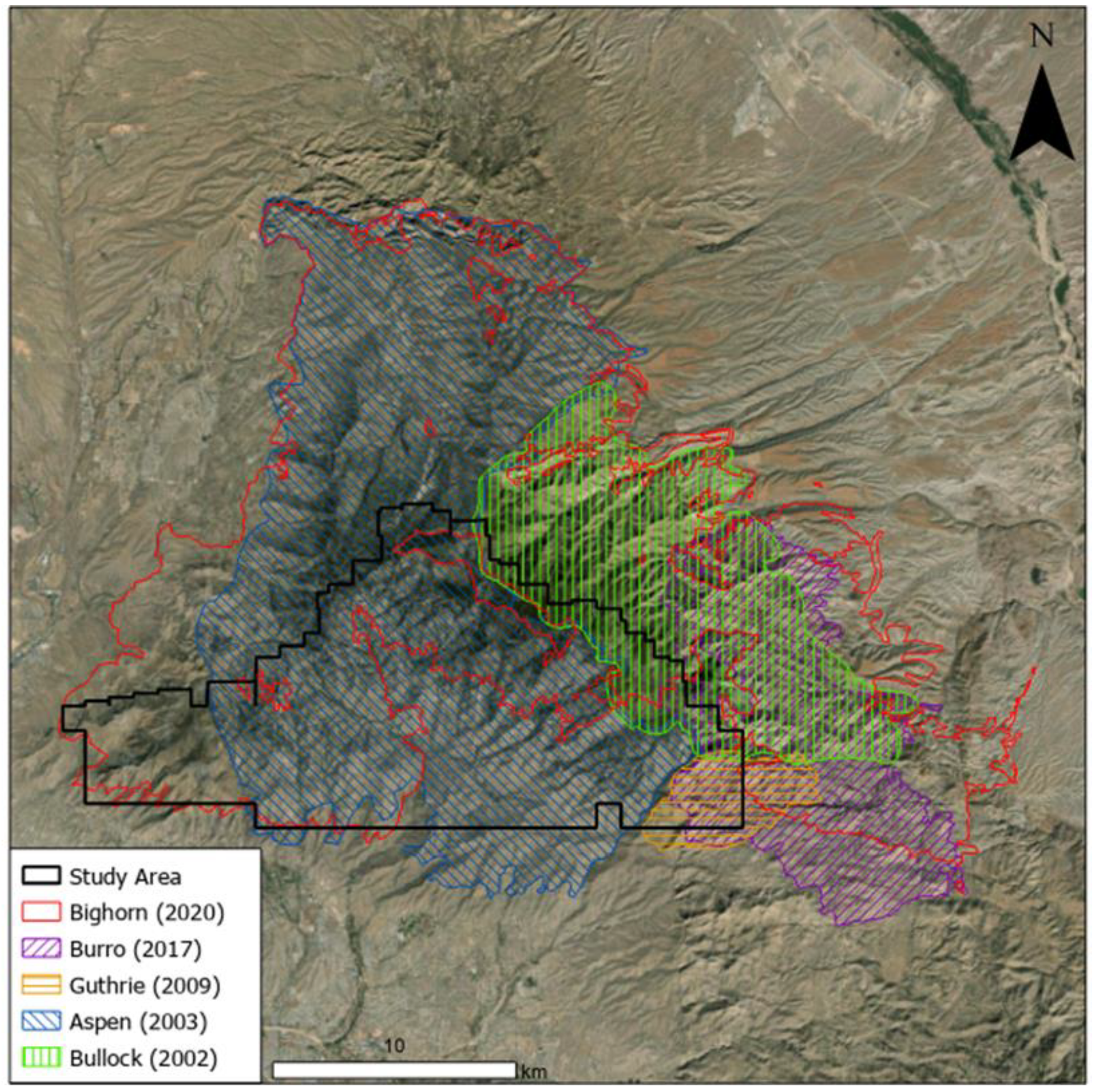
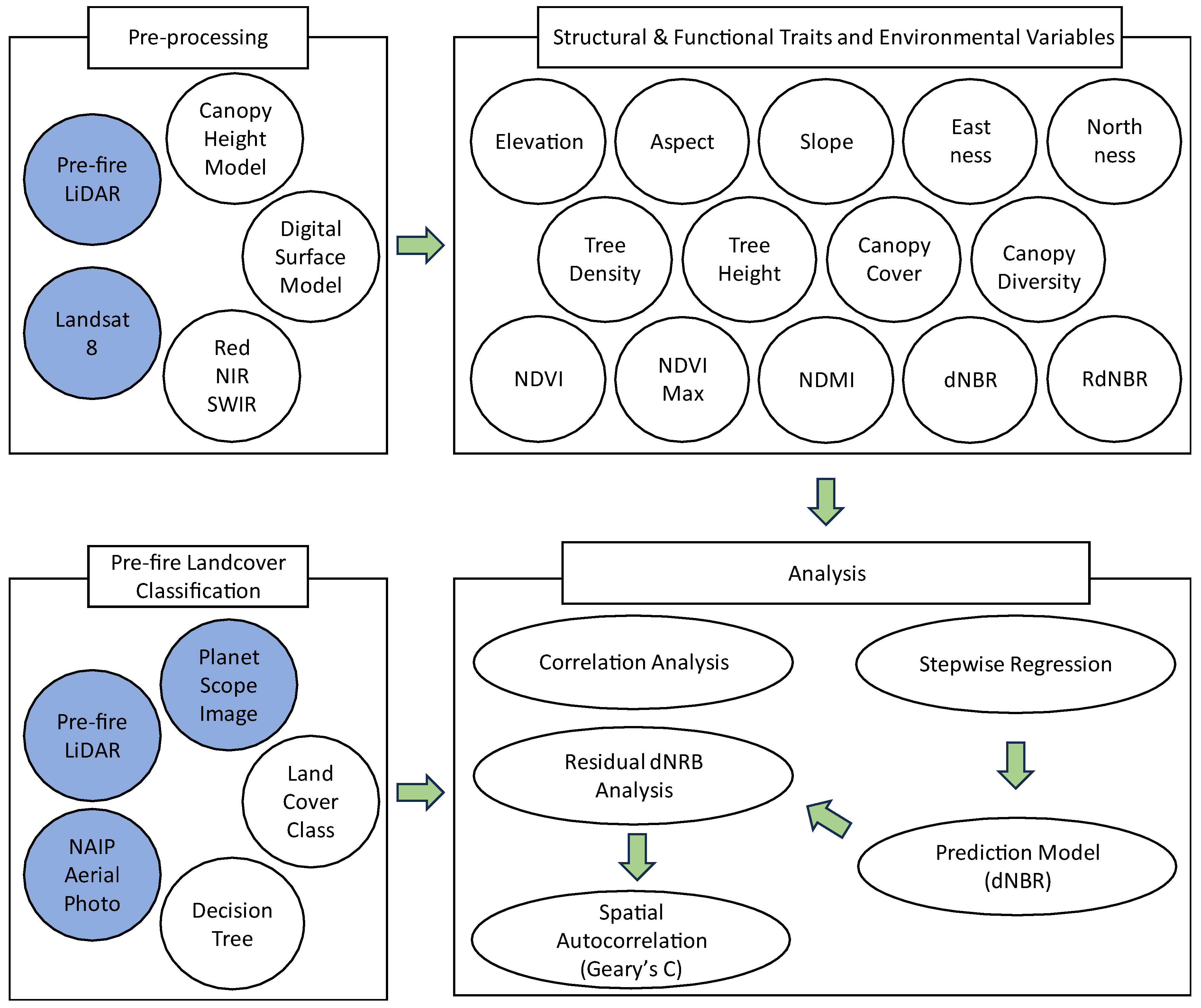
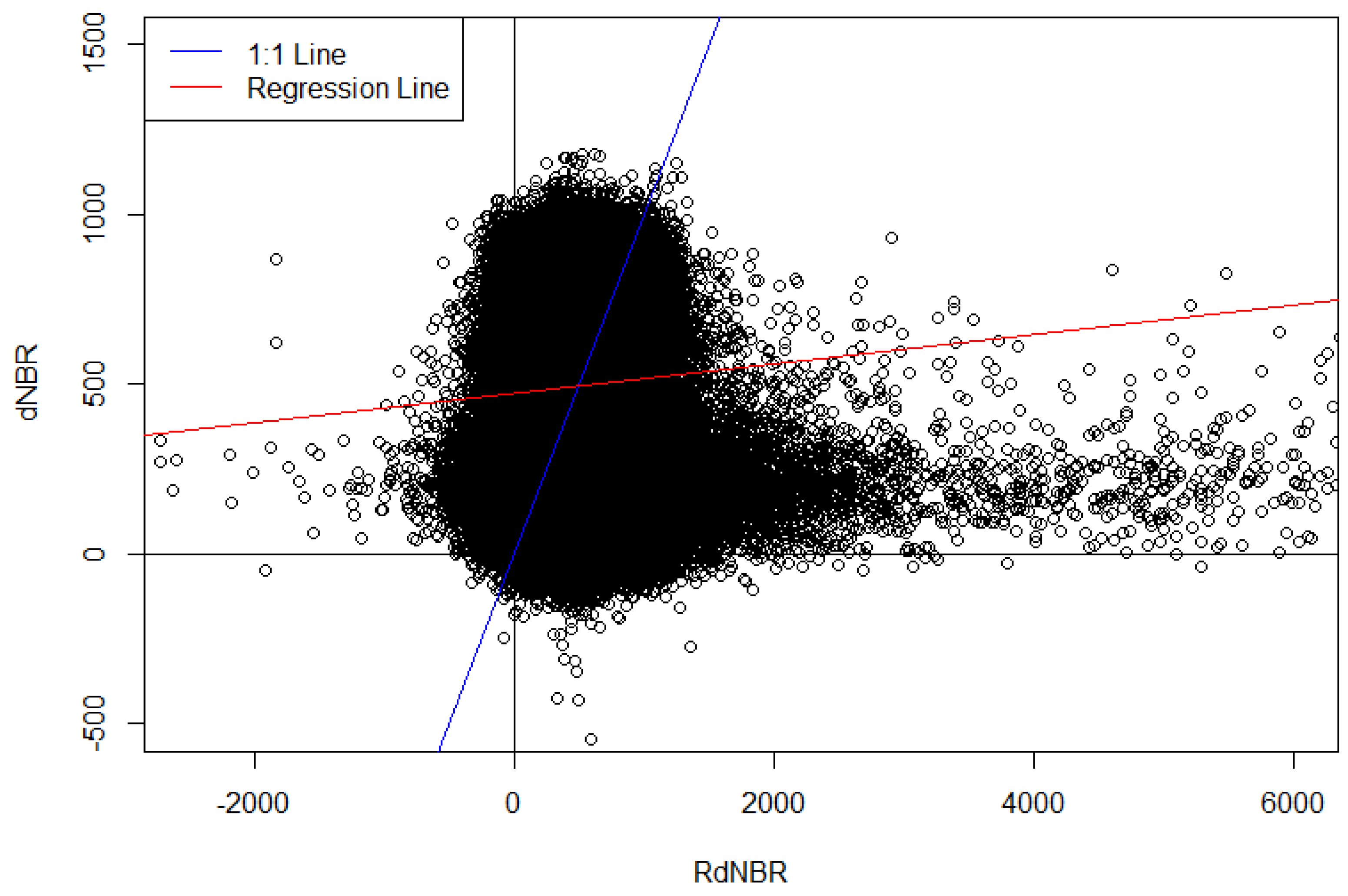
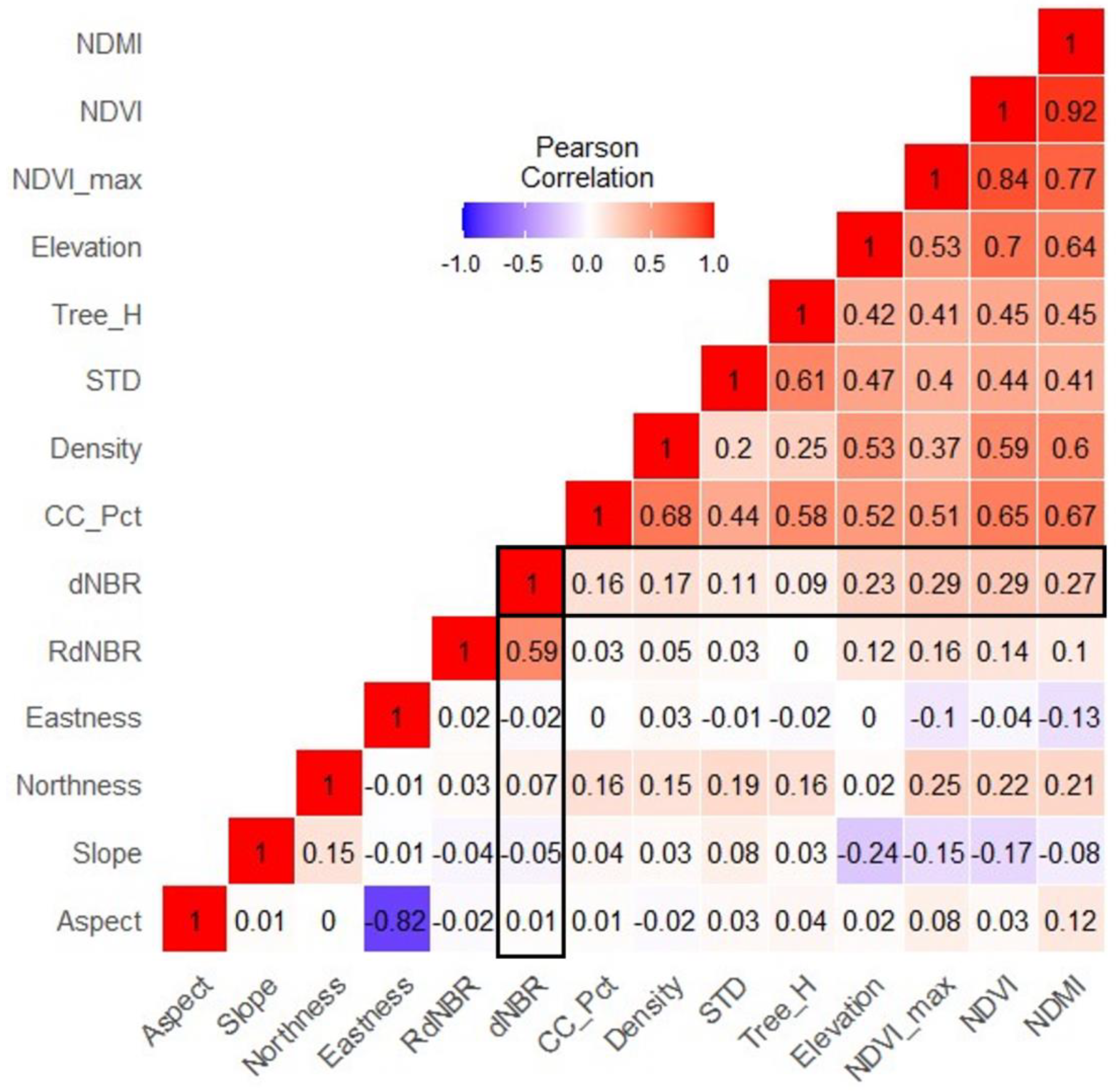
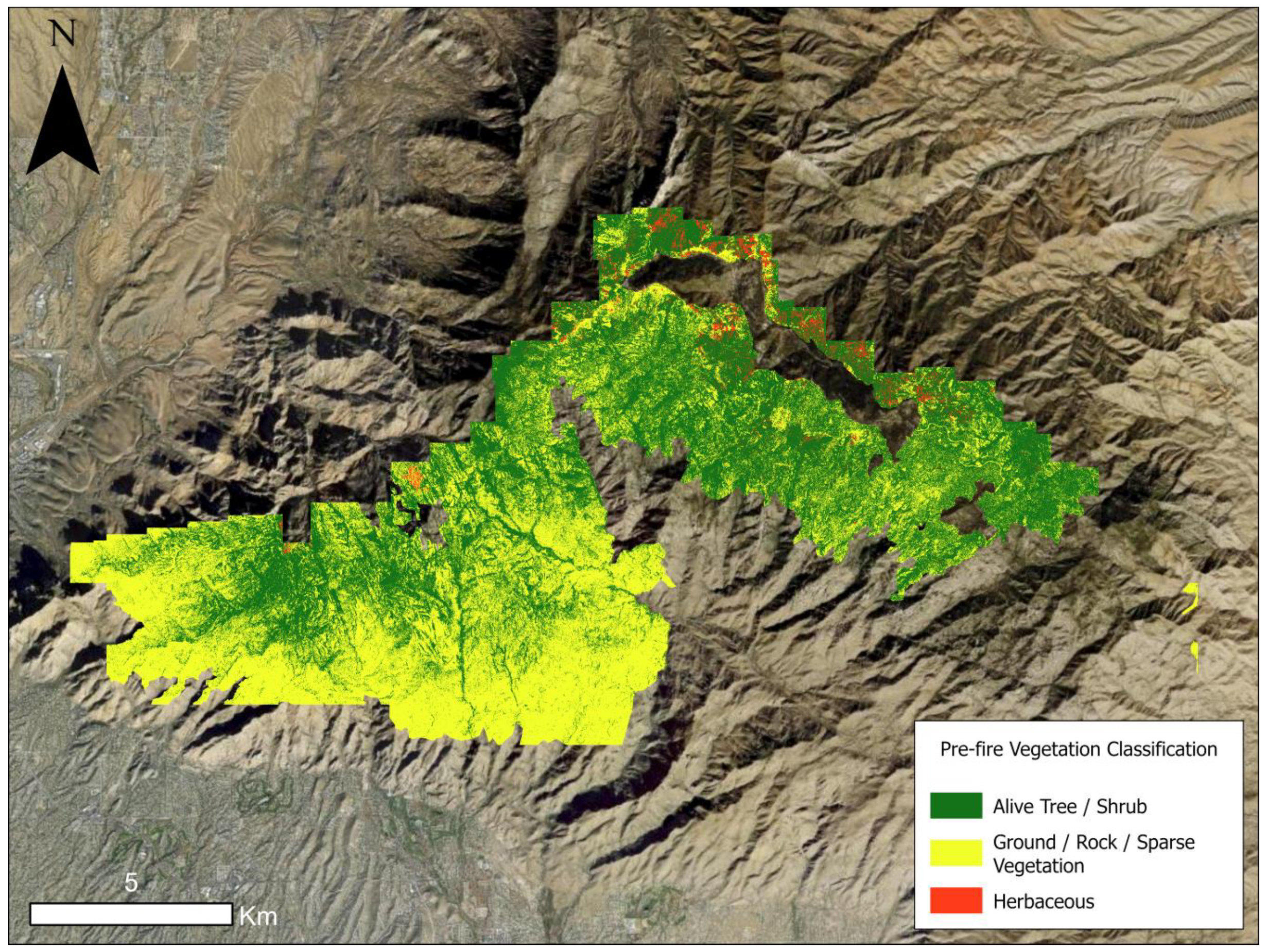
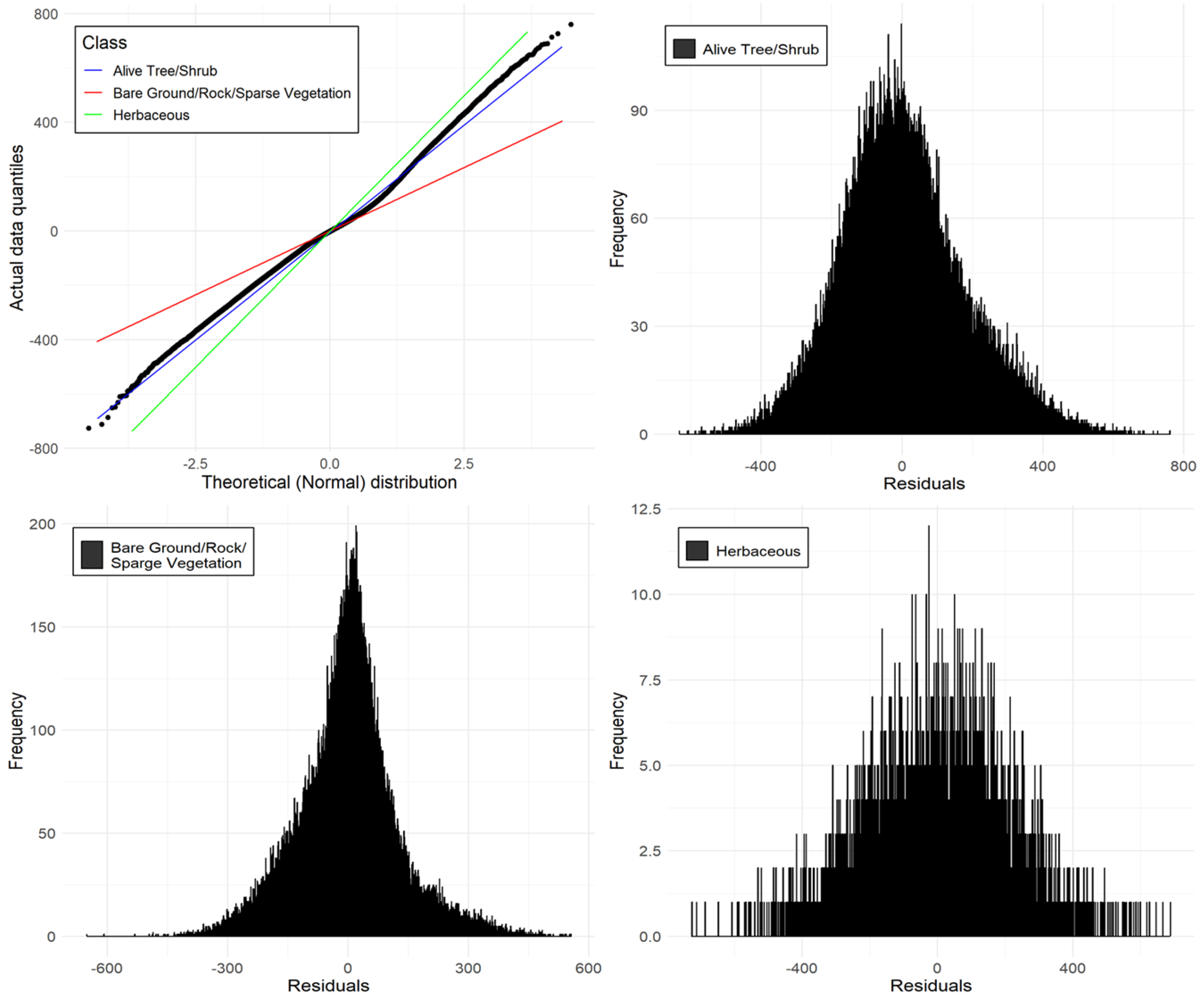
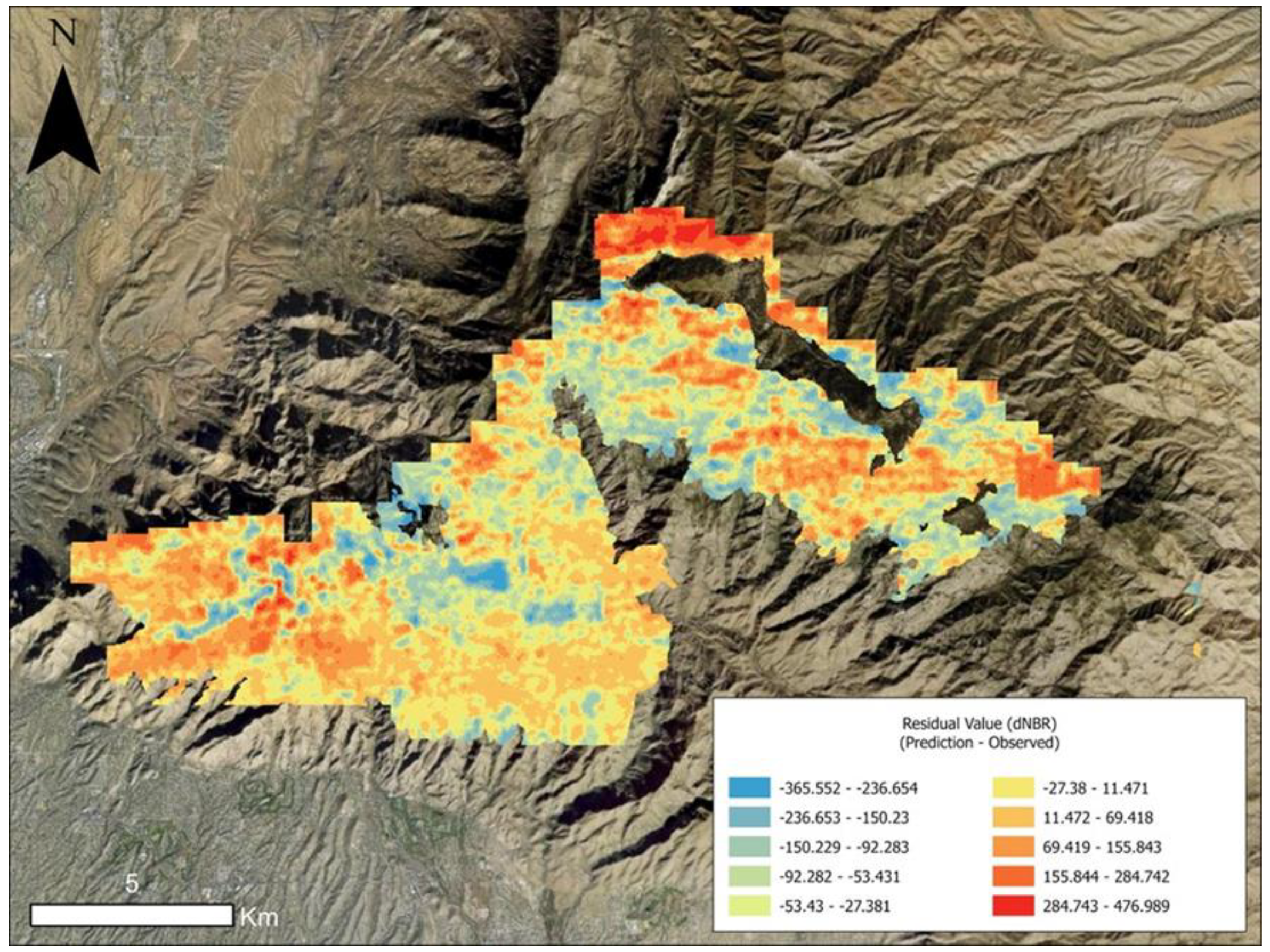
| Burn Severity | Ecological Description | |
|---|---|---|
| Unchanged | −100 to +99 | Indicates that the area one year after the fire was indistinguishable from pre-fire conditions. This may indicate that the area did not burn. |
| Low | +100 to +269 | Areas of surface fire with little change in cover and little mortality of the structurally dominant vegetation. |
| Moderate | −270 to +659 | A mixture of effects on the structurally dominant vegetation. |
| High | +660 to +1300 | Areas of high to complete mortality of the dominant vegetation. |
| Thematic Classes | Feature Properties |
|---|---|
| Alive Tree/Shrub | Green vegetation spectral signature and have heights associated with it (>1 m height). |
| Bare Ground/Rock/ Sparse Vegetation | No green vegetation spectral signature and do have low canopy heights (<1 m height). |
| Dead Tree/Shrub | No green vegetation spectral signature, but do have canopy heights (>1 m height). |
| Herbaceous | Green vegetation spectral signature but have low height (<1 m). This includes green grasses, forbs, and ferns. |
| Land Cover | Alive Tree/Shrub | Ground/Rock/Sparse Vegetation | Herbaceous | AllL and Cover |
|---|---|---|---|---|
| Slope | * | * | ||
| Aspect | * | |||
| NDVI | * | * | * | * |
| Canopy Cover | * | * | * | * |
| NDMI | * | * | * | |
| Northness | ||||
| Eastness | * | * | ||
| NDVI_Max | * | * | * | |
| Elevation | * | * | * | |
| Tree Density | * | * | * | * |
| Standard Deviation of Canopy Height | * | * | * | |
| Tree Height | * | * | * | |
| 0.30 | 0.28 | 0.29 | 0.36 |
| Land Cover | Geary’s C | Expectation | Variance | p-Value |
|---|---|---|---|---|
| Live vegetation | 185.9120 | 0.5192856 | 1 | 0 |
| Ground | 134.4589 | 0.6440652 | 1 | 0 |
| Herbaceous | 55.8227 | 0.4406085 | 1 | 0 |
Disclaimer/Publisher’s Note: The statements, opinions and data contained in all publications are solely those of the individual author(s) and contributor(s) and not of MDPI and/or the editor(s). MDPI and/or the editor(s) disclaim responsibility for any injury to people or property resulting from any ideas, methods, instructions or products referred to in the content. |
© 2024 by the authors. Licensee MDPI, Basel, Switzerland. This article is an open access article distributed under the terms and conditions of the Creative Commons Attribution (CC BY) license (https://creativecommons.org/licenses/by/4.0/).
Share and Cite
Lee, K.; van Leeuwen, W.J.D.; Gillan, J.K.; Falk, D.A. Examining the Impacts of Pre-Fire Forest Conditions on Burn Severity Using Multiple Remote Sensing Platforms. Remote Sens. 2024, 16, 1803. https://doi.org/10.3390/rs16101803
Lee K, van Leeuwen WJD, Gillan JK, Falk DA. Examining the Impacts of Pre-Fire Forest Conditions on Burn Severity Using Multiple Remote Sensing Platforms. Remote Sensing. 2024; 16(10):1803. https://doi.org/10.3390/rs16101803
Chicago/Turabian StyleLee, Kangsan, Willem J. D. van Leeuwen, Jeffrey K. Gillan, and Donald A. Falk. 2024. "Examining the Impacts of Pre-Fire Forest Conditions on Burn Severity Using Multiple Remote Sensing Platforms" Remote Sensing 16, no. 10: 1803. https://doi.org/10.3390/rs16101803
APA StyleLee, K., van Leeuwen, W. J. D., Gillan, J. K., & Falk, D. A. (2024). Examining the Impacts of Pre-Fire Forest Conditions on Burn Severity Using Multiple Remote Sensing Platforms. Remote Sensing, 16(10), 1803. https://doi.org/10.3390/rs16101803









